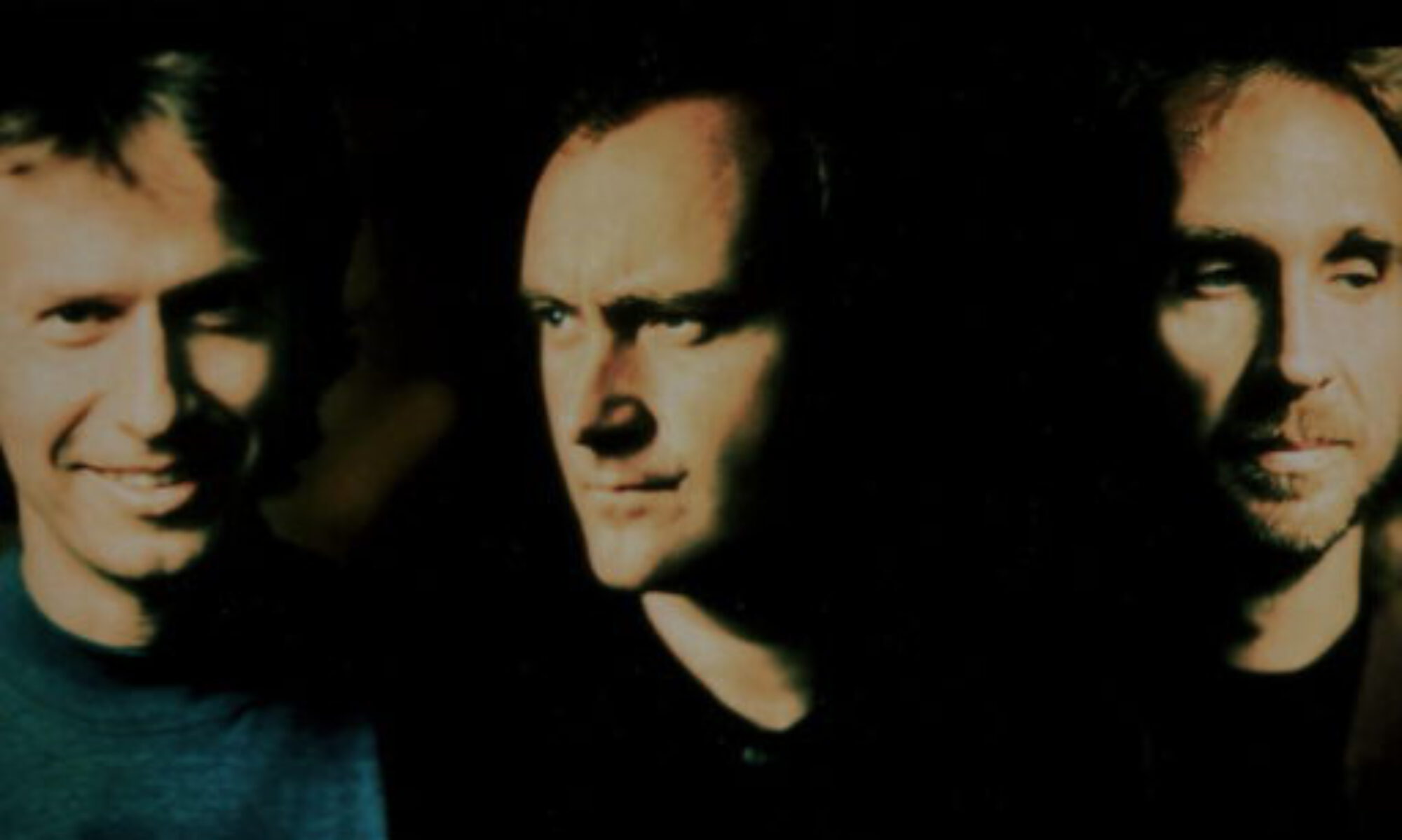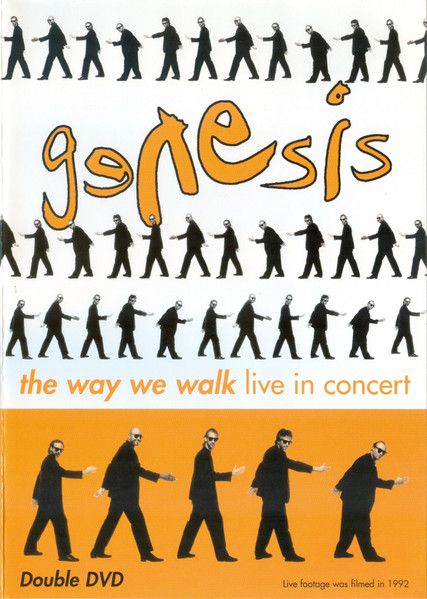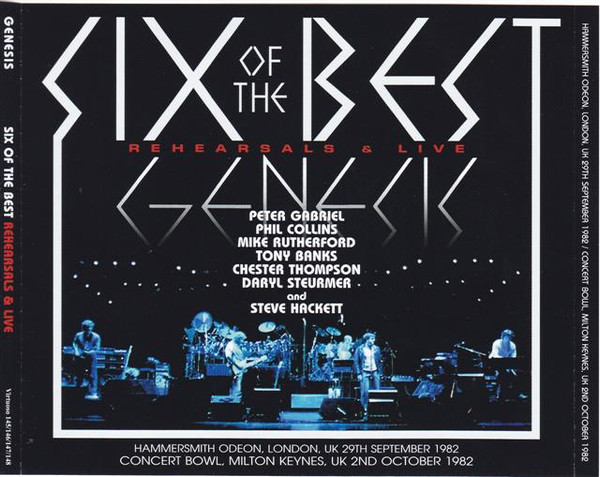The Way We Walk – Live in Concert, originally released in 1993 and reissued on DVD in 2001, offers fans an intimate and electrifying glimpse into the band’s We Can’t Dance tour. Filmed over three nights at London’s Earls Court in November 1992, this concert video is a vibrant showcase of Genesis’s remarkable musicianship and theatrical flair.
Continue reading “Genesis – The Way We Walk: Live in Concert DVD Review”Six Of The Best
On October 2, 1982, the legendary ‘Six Of The Best’ reunion show with Peter Gabriel and Genesis took place at Milton Keynes.
Continue reading “Six Of The Best”The ‘Turn It On Again’ Reunion Tour
On 11 June 2007, Genesis kicked off their long-awaited ‘Turn It On Again’ reunion tour in Helsinki, marking the official return of Phil Collins as lead vocalist.
The Reunion Announcement
On 7 November 2006, Tony Banks, Mike Rutherford and Phil Collins held a press conference to announce that Genesis would reunite for a European summer tour in 2007, followed by a North American leg in the autumn. It was the first time Collins had officially rejoined the band since leaving in 1996, despite a few brief appearances over the years.
Joining them on stage were longtime touring members Chester Thompson (drums) and Daryl Stuermer (guitar/bass), both of whom had not performed with Genesis since the We Can’t Dance Tour in 1992.
Rehearsing After 15 Years
The band’s first full show was scheduled for 11 June in Helsinki. With no new album to promote, Genesis had the freedom to revisit their extensive back catalogue. But rehearsing after a 15-year hiatus came with unexpected challenges.
Tony and Mike not only had to relearn many of the songs, they also had to transpose them to accommodate Phil’s deeper vocal range. Phil, in turn, had to reacquaint himself with lyrics, particularly those written by Tony Banks, which he had always found tricky. Songs like “Domino” and “Home By The Sea” with lines such as “Sheets of double glazing” or “Nylon sheets and blankets” had always tested his memory.
Listening back to past live performances, Phil noticed how often he had deviated from the original songs. For this tour, he made a conscious effort to stick to the original versions.
On top of that, he had to get back into Genesis drumming shape. While he had continued to play on solo tours, most notably during “In the Air Tonight”, tackling complex pieces like “Second Home By The Sea” required serious effort. Thankfully, Chester and Daryl were there to support the process, with Daryl even helping Tony and Mike remember their own parts.
Despite the time apart, the old chemistry was still intact. In fact, the dynamic between the three had improved. Tony and Mike had mellowed with age, while Phil had grown more serious. This allowed them to communicate more openly, discussing things they wouldn’t have dared bring up 15 years earlier.
The Setlist
Genesis had a vast library of music to choose from and the setlist reflected that. Fan favourites like “Follow You Follow Me”, “Invisible Touch”, “Mama”, and “I Can’t Dance” were all included.
One highlight was a heavier version of “Land of Confusion”, clearly influenced by Disturbed’s popular metal cover. It gave the song a modern edge and fresh energy.
The band also included more intricate tracks from the later years, such as “Domino” and “Home By The Sea”, two of Tony Banks’s personal favourites. They opened the show with a medley titled “Duke’s Intro”, combining the instrumental from “Behind the Lines” with a section of “Duke’s End”. It made for a powerful, dramatic opening that set the tone for the entire night.
Phil played more drums than he had on previous tours, and for “I Know What I Like”, he even brought back the iconic tambourine dance from 1976, something he had to rehearse again after years off.
Two surprises in the setlist were “Ripples”, from 1976’s A Trick of the Tail (Phil’s first album as lead vocalist), and a fragment of “Duke’s Travels”, which was folded into a medley. In fact, the set covered nearly every album from 1973 onwards. Each show ended on a high note with the emotional “Carpet Crawlers”, a beloved classic from The Lamb Lies Down on Broadway.
Behind the Scenes
Stage design for the tour was handled by the legendary Mark Fisher, while Patrick Woodroffe created a stunning lighting design. A massive screen behind the band displayed visuals tailored to each song, giving every track a unique atmosphere.
Nick Davis oversaw the live sound, and the band partnered with the Encore Series to offer high-quality soundboard recordings of every show, making each concert available to fans.
Opening Night in Helsinki
The tour kicked off in Helsinki on a warm summer night. The band delivered a flawless performance, the visuals hit every cue, and fans were thrilled to see Genesis live once again.
Phil would later reflect that while many had hoped for a new Genesis album, the ‘Turn It On Again’ tour felt more like a farewell than a comeback. The band continued through North America in the autumn before bringing the curtain down.
Looking back, all involved agreed: the best part of the tour wasn’t just the music, it was the joy of being back with old friends and laughing together again.
Photo: Genesis, ofwel: Phil Collins, Michael Rutherford, Tony Banks, Chester Thompson en Daryl Stuermer.}} |Source=Maikel Koek, via Wikiportrait |Date= |Author=Maikel Koek |Permission={{Wikiportrait|2008041010026495}} (https://creativecommons.org/licenses/by/3.0).
Duke (1980) – Genesis
The Album That Defined a New Era for Genesis
On March 28, 1980, Genesis released Duke, an album that marked a return to their roots as a band that thrived on jamming and improvisation. After years of bringing in individually written songs, the trio rediscovered the creative spark of working together. The result? One of their most celebrated albums—featuring the instant classic “Turn It On Again.”
Phil Collins Steps Into the Spotlight as a Songwriter
By the end of their grueling 1978 world tour, Phil Collins’ personal life was in turmoil. His marriage had fallen apart due to the relentless touring schedule, and in a last attempt to save it, he took a break from Genesis. While Tony Banks and Mike Rutherford used the time to release their first solo albums, Phil moved to Canada to try and rebuild his family life.
But it wasn’t meant to be. When his efforts failed, Phil returned to England, alone in his home in Surrey, and turned to music as an outlet – something he had never done quite like this before. For the first time, he began writing songs on his own, setting the stage for his future solo success.
Genesis Reignite Their Creative Energy
In 1979, Genesis regrouped at Phil’s home to start work on their next album. To Tony and Mike’s surprise, Phil had become a songwriter in his own right. While each member brought in individual ideas, the real magic happened when they began jamming again – something they hadn’t done since Peter Gabriel left the band. The result was a fresh, modern sound that still had the unmistakable Genesis touch.
“Turn It On Again” – The Song That Became a Genesis Anthem
Fans got their first taste of the new album in early March 1980, when Turn It On Again was released as a single. From the very start, it was clear this was a defining Genesis track.
Built around a complex 13/8 time signature, the song somehow felt effortlessly catchy -listeners didn’t even notice the odd rhythm until they tried to clap or tap their feet along with it. The song became a staple of Genesis’ live shows, appearing on every tour since its release. From 1983 onward, it was transformed into a high-energy rock medley, featuring snippets of classic cover songs.
Turn It On Again wasn’t just a hit; it became synonymous with Genesis. The band later named a greatest hits collection after it (Turn It On Again: The Hits) and even titled their 2007 reunion tour Turn It On Again – The Tour.
On an album filled with outstanding tracks, this driving, offbeat number had a special place. It reached #8 on the UK charts, earning Genesis a live performance on Top of the Pops – a rare treat for the band at the time.
Duke – The Story of Albert
The album itself, Duke, was released in late March 1980 and became Genesis’ first-ever UK #1 album.
Its artwork introduced the world to Albert, the faceless character on the cover, and the music inside told a loose narrative about fame, fortune, and downfall. The album opened with Behind The Lines, a grand, euphoric track that quickly shifted into a soulful, anthemic song – a bold statement from a band entering the new decade.
Together, Phil, Tony, and Mike proved once again that they were the core of Genesis, the same trio behind some of their greatest musical moments: the ‘Apocalypse of 9/8’-climax of “Supper’s Ready,” the instrumental finale of “The Cinema Show,” and large portions of The Lamb Lies Down on Broadway.
“Misunderstanding” – A Glimpse into Phil Collins’ Future
Despite the collaborative approach, each band member contributed individual songs to Duke. Among them was Misunderstanding, one of the first songs Phil ever wrote entirely by himself for Genesis.
Unlike their usual intricate arrangements, Misunderstanding was a straightforward, heartfelt pop song, with simple yet effective lyrics and a laid-back groove. Surprisingly (or maybe not), it became a bigger hit in the U.S. than in the UK, reaching the Top 20 and offering an early glimpse of Phil’s future success as a solo artist.
A Favorite Among Fans – and the Band
Duke remains a favorite among Genesis fans, and Tony Banks often cites it as one of his personal top Genesis albums. He especially highlights “Duchess”, a song that blends Genesis’ progressive roots with their evolving pop sensibilities.
As the first Genesis song to feature a drum machine, Duchess set the stage for much of their later work. The song’s story about an artist’s rise and fall even mirrors the band’s own journey – a theme that made it particularly special for Tony. Despite its deceptive simplicity, he considers it to be as emotionally powerful as “Supper’s Ready.”
Duke – The Album That Redefined Genesis
With Duke, Genesis proved they could balance artistic ambition with mainstream appeal. It marked a transition – a bridge between their progressive past and the radio-friendly sound that would define their 1980s success.
More than 40 years later, it remains one of their most important albums.
🎧 What’s your favorite track from Duke? Let us know in the comments!




